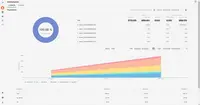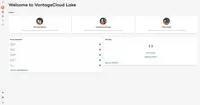Overview
What is Teradata Vantage?
Teradata Vantage is presented as a modern analytics cloud platform that unifies everything—data lakes, data warehouses, analytics, and new data sources and types. Supports hybrid multi-cloud environments and priced for flexibility, Vantage delivers unlimited intelligence to build the future of…
Awards
Products that are considered exceptional by their customers based on a variety of criteria win TrustRadius awards. Learn more about the types of TrustRadius awards to make the best purchase decision. More about TrustRadius Awards
Reviewer Pros & Cons
Pricing
Teradata VantageCore
$0
Teradata VantageCloud Lake
$0
Entry-level set up fee?
- Setup fee optional
Offerings
- Free Trial
- Free/Freemium Version
- Premium Consulting/Integration Services
Product Demos
Teradata ClearScape Analytics Experience Web
Product Details
- About
- Integrations
- Competitors
- Tech Details
- Downloadables
- FAQs
What is Teradata Vantage?
Teradata Vantage is a connected multi-cloud data platform for enterprise analytics that unifies data lakes, data warehouses, analytics and new data sources and types. Supporting hybrid, multi-cloud environments and priced for flexibility, Vantage aims to deliver unlimited intelligence to build the future of business. Teradata Vantage can be deployed on public clouds-as well as on premises with Teradata IntelliFlex, or on commodity hardware with VMware.
Teradata Vantage offers
- Agile business user productivity – from Teradata Vantage’s fast parallel performance, 1012 compute node scalability, and workload management, driven by Teradata’s cost-based optimizer that minimizes compute and IO costs while delivering results faster. Business users wait seconds or minutes, not hours to make well-informed decisions.
- Modern cloud native services – with on-demand cloud instances, native object storage read/write access, VantageCloud Lake Console for IT and business user control, and pay-as-you-go pricing. Includes hybrid and multi-cloud AWS, Azure, Google public clouds and on-premises VMware private clouds.
- Built-in parallel AI/machine learning and MLOps – with over 140 data science algorithms Vantage scales machine learning by training models on more than 1 million observations, and scoring them against more than 250 million observations multiple times per day. Plus, built-in MLOps that detects model drift and automates model rebuilding.
Teradata Vantage Screenshots
Teradata Vantage Integrations
Teradata Vantage Competitors
Teradata Vantage Technical Details
| Deployment Types | On-premise, Software as a Service (SaaS), Cloud, or Web-Based |
|---|---|
| Operating Systems | Linux |
| Mobile Application | No |
| Supported Countries | Global |
| Supported Languages | English, French, German, Japanese, Korean, Russian, Chinese, Spanish, Portuguese, +15 more |
Teradata Vantage Downloadables
- Unit pricing for Teradata VantageCloud Lake is offered through a consumption-based, pay for what you use model. This describes how VantageCloud Lake unit pricing works, and goes over the various package options.
- Introducing Teradata VantageCloud Lake: A new offer based on Teradata’s next-generation cloud-native architecture.
- How Teradata Vantage on VMware offers a flexible way to enhance business insights and bring faster time to value.



